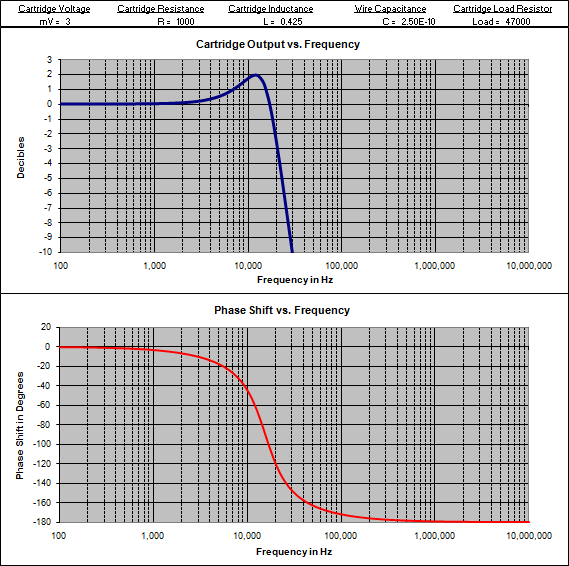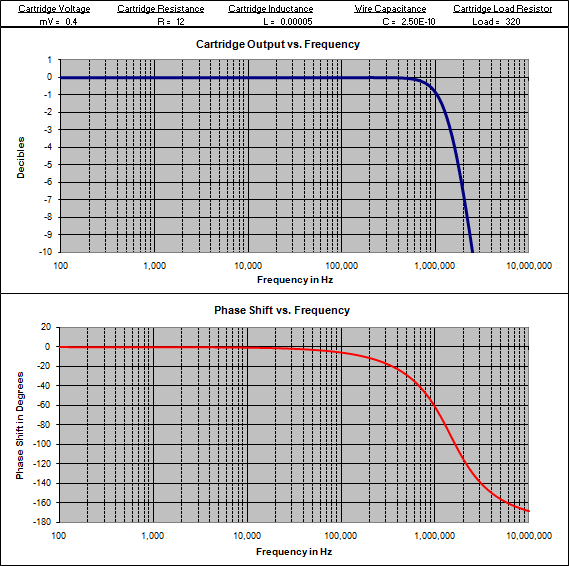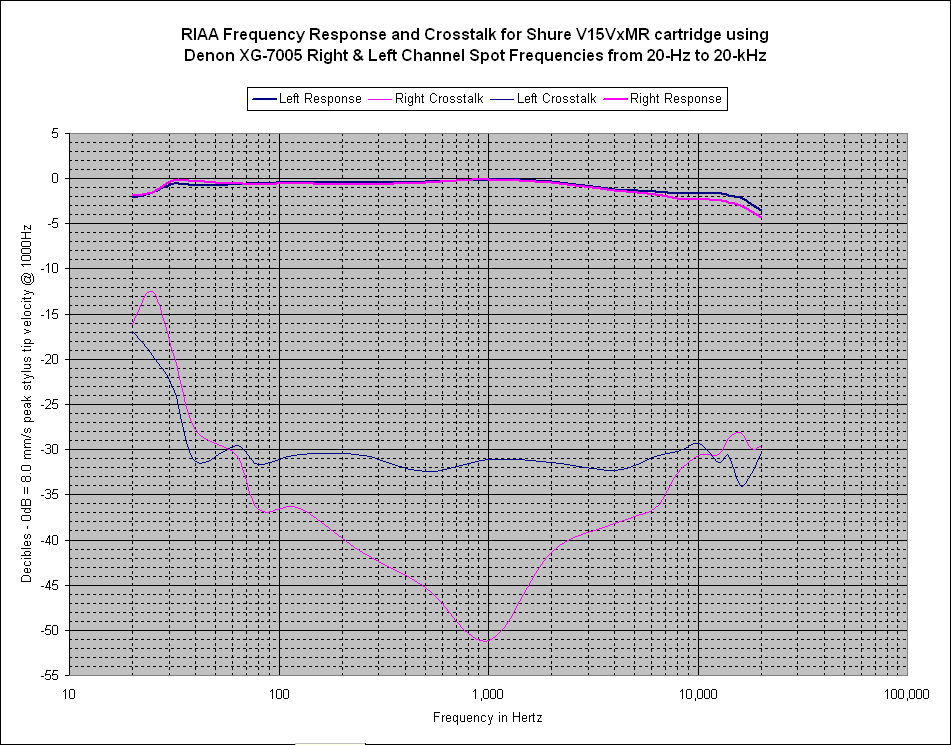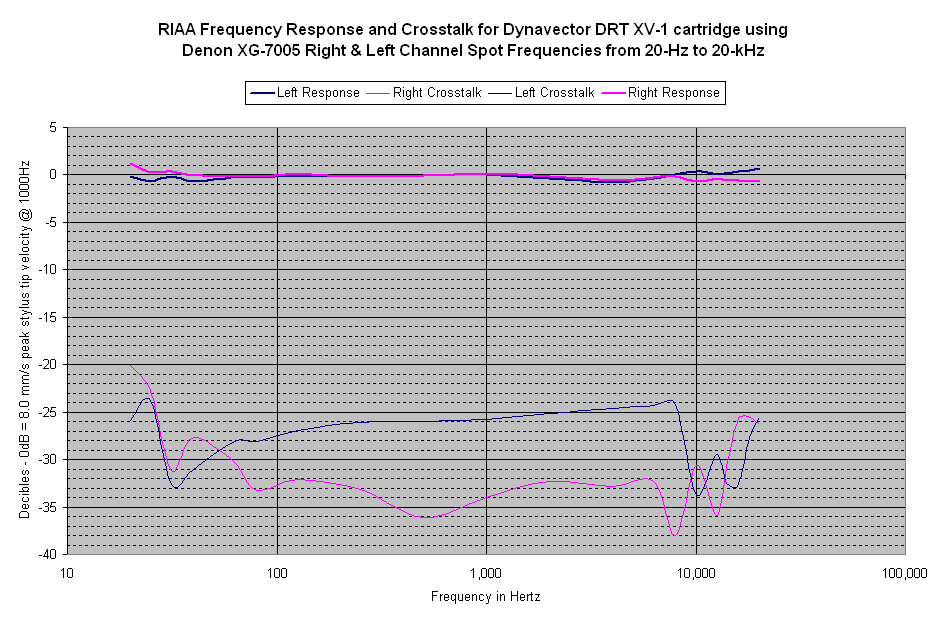 |
Audio Asylum Thread Printer Get a view of an entire thread on one page |
For Sale Ads |
 |
Audio Asylum Thread Printer Get a view of an entire thread on one page |
For Sale Ads |
68.32.170.10
In Reply to: RE: They simply sound better to me... posted by John Elison on February 28, 2011 at 14:39:03
But I don't think that's a surprise to anyone who knows me.
I do have an engineering type question. Since the higher inductance of a traditional MM/MI cartridge combines with the capacitance and resistance of the phono preamp and forms a low pass filter, does this filter have effects on frequencies below the effective frequency of the filter?
Since this effective frequency using a traditional MM/MI cartridge is at the upper limit of human hearing, I am asking whether this low pass filter has any effects on harmonics of the effective frequency (in this case within the audible spectrum). My question comes from my limited understanding of tone controls in preamps.
Preamp designs started dropping tone controls from their designs due to the negative effects that those filters had on frequencies that were multiples of the effective frequency designed into the tone control. Since the MM/MI cartridge forms a low pass filter, I am thinking there isn't a free ride there either.
If my limited understanding is correct and the MM/MI cartridge forms a low pass filter around 20kHz and that filter has effects on multiples of that effective frequency then we have a negative side effect. Perhaps phase issues or other things we disposed of tone controls for...
Let me know if I am off base here John.
Thanks,
Ed
We don't shush around here!
Life is analog...digital is just samples thereof
Follow Ups:
Hi Ed,
You raise an interesting point. Yes, I believe there are phase shift consequences of the electrical resonance that occur well below the resonance frequency itself. This can be demonstrated with a simply circuit that I found on Jim Hagerman's website for modeling the electrical parameters of phono cartridges.

Using this circuit, it is possible to look at the theoretical frequency response and phase response of different phono cartridges. For example, the two graphs below show an electrical model of the Shure V15VxMR, first with no load and second with the standard 47k-ohm load. The no-load model clearly shows the cartridge's electrical resonance at 15,440-Hz with its associated phase reversal whereas the loaded model shows the resonance when damped with the standard 47k-ohm phono stage. Notice how phase shift now begins below 1000-Hz and reaches 120-degrees at 20-kHz in the loaded model.
......

Now, let's look at a low-output moving coil like the Audio Technica OC9. The unloaded model clearly shows the cartridge's 1.424-MHz electrical resonance and the associated phase reversal, but when the cartridge is loaded at 320-ohms its electrical resonance is completely damped and phase shift still remains absolutely negligible within the audible range.
......

There is no question in my mind that the electrical parameters of low-output moving coil cartridges represent a far superior design than that of any high-output type of cartridge.
Best regards,
John Elison
It makes sense. I spent a lot of money back in the day on a lot of cartridges and felt disappointed for one reason or the other. This is a possible explanation of a measurable and audible difference.
Ed

We don't shush around here!
Life is analog...digital is just samples thereof
"It makes sense. I spent a lot of money back in the day on a lot of cartridges and felt disappointed for one reason or the other. This is a possible explanation of a measurable and audible difference."
It's a little ironic that you use that term. I'm really not trying to beat a dead horse or make anyone look bad. I think the Hagerman model is flawed. Phase angle and frequency response go hand in hand with a low pass filter. The graphs above just don't look like they reflect the measured response of a V-15V. This is well documented.
I also think the resistance/inductance of high output cartridges tend to compromise performance in an ultimate sense. I happen to have a LOMM that has 1mH inductance and 3 ohms resistance. After listening to it for awhile, you can tell that it is a MM and not a MC. Others have said the same. Perhaps there are factors other than inductance/resistance that account for this.
On another note, is Comet a reliable source that will stand behind their sales if there's a problem? Maybe nobody has received a defective cart or one damaged in shipment. I guess you could cancel the charge if it hasn't been too long.
How about CineMags for $100? I've seen them advertised for $400. They're sold direct for DIY?
neo
BIRD LIVES
So to speak. The stuff on the Hagermann site is a pretty good example of the electrical characteristics of a cartridge interfaced into a phono preamp load. Its not theory, its just plain electrical engineering.
That's how they get the loading recommendations they come up with for various cartridges. That plus a bit of listening.
I'm not bashing MM or MI cartridges, I'm just trying to understand why I didn't prefer the sound of the cartridges I owned many years ago. There had to be a reason that I found so many cartridges lacking.
The point I'm trying to make, and John tried to make, is that the electronics and science is not theory. Its just the way it is. A low pass filter has effects on frequencies below the effective frequency of the filter. That's why tone controls are frowned upon in modern designs or why modern preamps have tone control bypass switches in the design.
The tone control doesn't just effect the place it is supposed to effect, it effects frequencies lower (for low pass filters) and above (for high pass filters) the intended points. The loading of a high inductance cartridge is a low pass filter and it reckons that the low pass filter will effect the frequencies below 20kHz. Not theory, just electronics.
Whether this is objectionable or not is up to the listener.
Ed

We don't shush around here!
Life is analog...digital is just samples thereof
This is looking at the cartridge resistance and inductance, shunt capacitance and loading resistance, in isolation. Then conclusions are drawn about phase at the output of a preamp.
A low pass filter's phase behavior depend on the type of filter. There are other electronics in the signal chain past shunt loading that are ignored. So we have a 15.4K (in this case) electrical resonance that doesn't show up on the measured response. Then we're told that the output is 120 degrees out of phase at 20K. This doesn't seem right to me. The proof I'm offered is laws of science crap and more of the same.
It wouldn't be all that hard to test, but I guess nobody has the equipment. Maybe it's right. Looks like we'll never know for sure.
neo
BIRD LIVES
At the input where it is amplified and then subject to the rest of the preamp's circuit related issues. Starting with a phase issue is not a good way to begin.
Its the KISS principle at work. Don't present a signal with added problems to be amplified if you don't wnat that content in the first place.
If the preamp in question accounted for the phase shift somehow then fine, but not so fine for a lower/higher inductance cartridge who's phase shift would occur in a different spectrum.
Just a bad start...thats all.
Ed

We don't shush around here!
Life is analog...digital is just samples thereof
Good points. I think the validity of this theoretical phase shift really is a preamp design consideration and not a given. BTW, so far I've seen no evidence of this phase shift at the output of a phono preamp. Most phono preamps have some kind of coupling cap at the input and there is cable capacitance, along with loading resistance, so I'm sure it is a consideration.
Assuming this is already a problem is an oversimplification, IMO. After the input, the signal goes through amplification and RIAA stages. As you probably know, a 4th order filter has zero phase shift. So if you're looking at this as the effect of a filter, look further. A filter is the total of the parts that make up that filter, not an isolated cap in front. I suspect that a well designed phono stage will have the same amount of phase shift on a cart with electrical resonance at 15.44KHz, as any cart, regardless of electrical resonance. That theoretical phase shift should be as prominent in the output as the electrical resonance - nonexistent.
neo
BIRD LIVES
This could be one of the reasons that LOMC users prefer those cartridges over the MM/MI or HOMC variants. In practice there are many mitigating factors but there is little disagreement that LOMCs or low inductance MI/MM cartridges have a more extended frequency range and tend to sound more transparent.
Of course this is also subject to all of the problems present in the amplification chain and what is gained by the low inductance could be lost in the needed extra amplification.
In the end there is no free ride and what works for one of us cannot be assumed a solution for others. I have heard numerous other rigs with LOMCs and high output MM cartridges. Whatever advantage the low inductance cartridges have it cannot be realized unless the care is taken to match it to the right rig.
A top quality MM can be very enjoyable but I have noted that the low level detail retrieval ability usually is found with the low output cartridges. I guess its a Murphy factor and the cartridges that have the better ability to retrieve very low level details present the most challenging problems to amplify that output.
Like anything in life, there is no free ride or perfect answers. Just choices.
Ed

We don't shush around here!
Life is analog...digital is just samples thereof
There are a lot of physical or mechanical differences as well and it can be difficult to ascribe a particular trait to one aspect of performance, whether it is mechanical or electrical. The fixed cantilever in most MCs might account for a large increase in low level detail. That could also pertain to transparency or clarity. But in general I think you're right about trading off higher inductance and resistance for lower voltage, assuming you can cleanly amplify that low output.
Still, I think recommending a LOMC to the OP is not a viable option. A DL103 isn't a particularly good match to a SL-1200 arm and using a MM gain stage is out of the question. A heavier headshell will also be some extra coin. I wouldn't sell my 103d for less than $200 even though it still needs a new tip. There's not much out there in LO carts + step-up for that money. My HO set-ups sound pretty nice and require no mods, which can be lots more money.
neo
BIRD LIVES
> The graphs above just don't look like they reflect the measured response of a V-15V. This is well documented.I've been measuring phono cartridge frequency response for more than 25-years. Can you show me a frequency response graph that you've measured?
My test records end at 20-kHz, but all the graphs I've measured from high-output cartridges seem to take a downward turn at the 20-kHz point. Moving coils, on the other hand, seem to remain level or take an upward turn at the 20-kHz point.
I think you are going to have to present all your well documented evidence if you wish to refute Hagerman's model. It is based on established electrical engineering principles that can be found in any electronics text book.
Best regards,
John Elison




Edits: 03/02/11
"My test records end at 20-kHz, but all the graphs I've measured from high-output cartridges seem to take a downward turn at the 20-kHz point. Moving coils, on the other hand, seem to remain level or take an upward turn at the 20-kHz point."
Many HO carts have or had response well past 20K. Some used for 4-ch had response to 40 or 50K (AT-20 series). The current AT-150 has response to 30K. Even if response is off at those frequencies, it would not necessarily indicate phase shift like you calculated for the V-15V. Those calculations are based on Hagerman's model. Using those electrical resonance calculation proves to to be of limited value when it comes to actual high frequency resonance. The mechanical aspects are a much greater factor and are of overwhelmingly greater importance. This was indisputably shown on VE thread Cartridge Loading Explained.
I don't think Hagerman's model is correct for the electrical aspect concerning phase shift. Shunt capacitance on the generator + the generator's own inductance create a 12dB/octave filter? This filter is independent of frequency response? BTW, the response graphs I remember for that cart seemed a little flatter. Maybe I don't remember them that well. Crosstalk seemed whacked. Azimuth off?
With your tone, I expected to see analyzer results with actual phono stage output. I don't care about refuting Hagerman. I want evidence that said phase shift is real. I don't believe it.
Peace,
neo
BIRD LIVES
> With your tone, I expected to see analyzer results with actual phono stage output.
I've shown you a whole lot more than you've shown me. Actually, I believe you've shown me absolutely nothing except for unsubstantiated bullshit. Hagerman's model is based on electrical fact. Until you can present something of substance there is no reason for me to continue a discussion with someone who I don't believe knows enough about the subject to understand the truth.
Peace to you, too.
John Elison
I'm making no claims, just skeptical. You on the other hand are claiming something based on theory. The onus of proof is on you. You say those plots are theoretical (up top), but based on electrical fact. Yet apparently you can't or won't prove it.
I think you would agree that a phono cartridge itself is a minimum phase device. In which case phase of any magnitude waveform is a function of the slope of the waveform. We don't normally see impedance curves for a phono cartridge, but your actual frequency magnitude waveform would appear to have minimal phase discrepancy. These plots you kindly provided would seem to indicate that. Thank you.
Good day,
neo
BIRD LIVES
You are the one suggesting that the laws of electricity and physics do not apply to phono cartridges.
My plots of frequency and phase are theoretical because they are not actual measurements but calculations based on the electrical parameters of specific phono cartridges using established laws of electricity and physics. You are telling me that you are skeptical and that you don't believe the laws of electricity and physics apply to phono cartridges, but you give no evidence to support your skepticism. Show me one measurement that supports your position.
I don't think I have to prove that phono cartridges adhere to the law of physics; I think you have to prove that they don't.
Good luck,
John Elison
"Show me one measurement that supports your position."
The measured frequency response of the cartridge shows no resonance peak at 15.44KHz.
Good luck to you too.
neo
BIRD LIVES
Your response only lends greater support to my position. The reason you see no resonance in the measured graph is because the phono stage load resistor damps the resonance. The calculated plot proves this to be true while also showing that phase reversal still occurs even though the resonance is damped. I really don't think you understand the physics involved.
Anyway, enjoy your audio hobby.
John Elison
OK, I know nothing whatsoever about physics or electronics, and I understand even less about them. The first time I saw the word ohm, I thought it was a typo. It looked like it should have been home.
"Using this circuit, it is possible to look at the theoretical frequency response and phase response of different phono cartridges."
Those are your words when introducing the calculated plots.
"The reason you see no resonance in the measured graph is because the phono stage load resistor damps the resonance. The calculated plot proves this to be true while also showing that phase reversal still occurs even though the resonance is damped."
You're offering theoretical plots as proof of the theory.
Have a nice day,
neo
BIRD LIVES
The phase issue is only one factor that determines the audible differences between MM/MI and MC cartridges. I was just making an observation.
I know that the Cinemags are the current price/performance champs if you want to go for a stepup trannie but I'm not a stepup man. I have used an active headamp since I switched to a LOMC back in 1979.
Stepup trannies add their own factors to the perceived sound. Some do their job really well and others not so well. Like all components.
I like the flexibility of an active headamp. You can change the loading without effecting the gain of the thing which is not possible with a passive component like the stepup.
Its a personal choice like all things in this hobby. An active headamp brings into play the noise of an additional gain stage. This is not the case of a stepup. The stepup has its own issues and is not a free ride either.
Ed

We don't shush around here!
Life is analog...digital is just samples thereof
Post a Followup:
| FAQ |
Post a Message! |
Forgot Password? |
|
||||||||||||||
|
||||||||||||||
This post is made possible by the generous support of people like you and our sponsors: